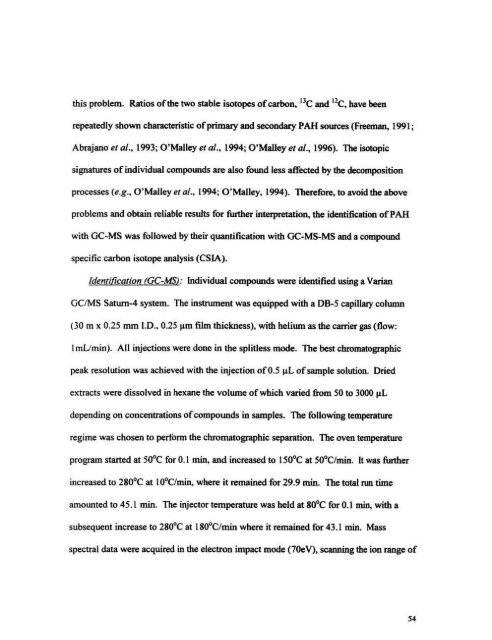I'r - Memorial University of Newfoundland
I'r - Memorial University of Newfoundland
I'r - Memorial University of Newfoundland
Create successful ePaper yourself
Turn your PDF publications into a flip-book with our unique Google optimized e-Paper software.
this problem. Ratios <strong>of</strong>the two stable isotopes <strong>of</strong>carbon, lJC and 12C. have been<br />
repeatedly shown characteristic <strong>of</strong>primary and secondary PAH sources (Freeman. 1991;<br />
Abrajano et al., 1993; O'MaUey et al., 1994; O'MaDeyet aI., 1996). The isotopic<br />
signatures <strong>of</strong>individual compounds are also found less affected by the decomposition<br />
processes (e.g., O 'Maileyet al.. 1994; O'Malley, 1994). Therefore, to avoid the above<br />
problems and obtain reliable results for further interpretation, the identification <strong>of</strong>PAH<br />
with GC-MS was followed by their quantification with GC-MS-MS and a compound<br />
specific carbon isotope analysis (CSlA).<br />
Identification fGC-MSJ: lndividual compoWKis were identified using a Varian<br />
GelMS Saturn-a system. The instrument was equipped with a DB-5 capillary cohunn<br />
(30 m x 0.25 mm l.0., 0.25 jim film thickness), with helium as the carrier gas(flow:<br />
1mUmin). All injections were done in the splitless mode. The best chromatographic<br />
peak resolution was achieved with the injection <strong>of</strong>0.5 ul, <strong>of</strong>sample solution . Dried<br />
extracts were dissolved in hexane the volume <strong>of</strong>which varied from 50 to 3000 ilL<br />
depending on concentrations <strong>of</strong>compounds in samples. The following temperature<br />
regime was chosen to perform the chromatographic separation. The oven temperature<br />
program started at SO"C for 0.1 min, and increased to 150"C at SO"CJmin. It was further<br />
increased to 280"C at to"CJmin, where it remained for 29 .9 min. The total nm time<br />
amounted to 45 .1 min. The injector temperature was held at 80"e for 0.1 min, with a<br />
subsequent increase to 280"C at 180"C/min where it remained for 43 .1 min. Mass<br />
spectral data were acquired in the electron impact mode (70eV), scanning the ion range <strong>of</strong><br />
54

















